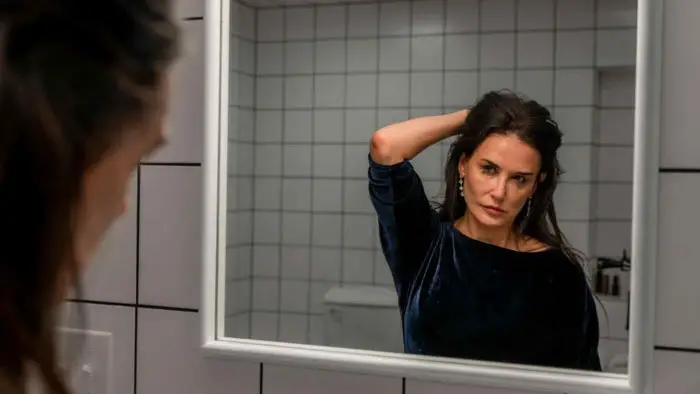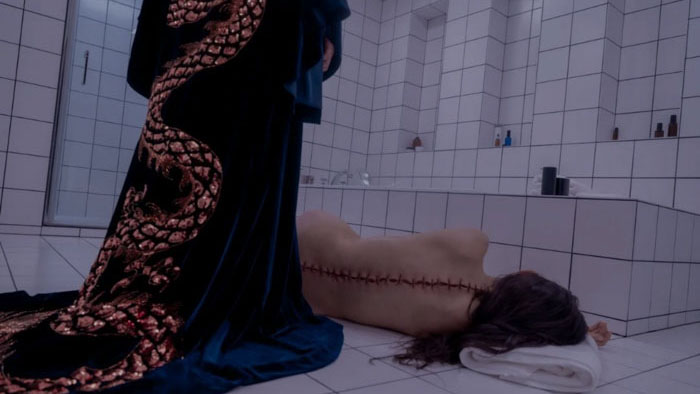
TORONTO INTERNATIONAL FILM FESTIVAL 2024 FEATURE! Sunset Boulevard by way of Cronenbergian bodily distortion — director Coralie Fargeat’s latest film, The Substance, is wickedly fun and continues the recent blockbuster trend of female-led horror flicks. The film follows Elisabeth Sparkle (Demi Moore), an aging Hollywood star who becomes desperate to revive her career by any means necessary. In dire straits, she turns to a mysterious black market drug, The Substance, which promises to produce “the best version of yourself,” a younger and more attractive clone named Sue (Margaret Qualley) grown from Sparkle’s own DNA. The catch? The two women must take turns living: seven days as Sue and seven days as Sparkle. The seasoned actress quickly realizes that this underground deal comes with its own set of bloody consequences as Sue, her younger double, begins to demand more and more — taking over Sparkle’s life. The tension between the two builds, leading to The Substance’s equally repulsive and electrifying conclusion.
Women and Horror
Women have always been a staple of the horror genre. Stalked, poked, prodded, and, ultimately, ripped apart, women are often used as sacrificial lambs in Hollywood’s attempts to spook audiences. Renowned horror director Dario Argento put it best when he said in an interview, “I like women, especially beautiful ones. If they have a good face and figure, I would much prefer to watch them being murdered than an ugly girl or man.”

“Watching the film, I found myself caught up in the cries, groans, and laughter of the audience…”
However, in recent years, popular film has seen an uptake in female-led and female-directed horror films. From Nanny to Saint Maude to Titane, the past half-decade has seen a renewed interest in not just women’s bodies on screen but their stories. The Substance takes up the torch on this front and produces by far the best contribution to the feminist body horror subgenre in recent years. As a character, Sparkle is expertly crafted and performed. Audiences watch on as her admiration for the double turns into envy, resentment, and eventually lethal hatred. And while these themes of coming into and aging out of gendered public favor are in keeping with other contemporary horror films this year, like MaXXXine and Immaculate, The Substance takes these topics and autopsies them using Fargeat’s flashy and seductively garish style. The film uses Los Angeles as a metaphor for experiencing womanhood, especially in the public eye. Behind its glitzy exterior is something much darker — bloody, decrepit, and oozing, itching to make its way to the surface. It is this reality that The Substance effectively underlines with a fine-point pen.
A Bloody Masterpiece
The Substance is not for the faint of heart. Bodies tear themselves open, teeth are ripped from the root, nails are peeled back, and bones crack and crumble to dust. However, at the same time, the film consistently relies on black humor to subvert viewer expectations. This is not a film that takes itself all that seriously. Watching this spectacle, you are constantly oscillating between disgust, astonishment, and laughter. Fargeat has mastered the art of emotional whiplash, leaving audiences nauseated and, at the same time, captivated. Watching the film, I found myself caught up in the cries, groans, and laughter of the audience and was ultimately left constantly questioning, “How can it get crazier than this?” Spoiler alert: it always did.

“The Substance takes these topics and autopsies them using Fargeat’s flashy and seductively garish style.”
The director has a mastery over film form. The colorful interior sets and bright sun-kissed landscape shots of California palm trees are striking to watch. Fargeat uses these locations to put in motion a drama of visual opposites — just like Sparkle and Sue. Fisheye shots of long hallways are contrasted by extreme close-ups of mouths eating messily — slurping, spitting, chewing. This sensorial opera does not only have to do with violence (although that is a large part of it), but bodily secretions and functions in general, emphasizing the commodification of female form in horror and Hollywood alike throughout the years.
The Future of Horror is Female
While some have criticized the film for its 140-minute runtime and the seemingly repetitive narrative rhythms, it is The Substance‘s insistence on process that is integral to its gendered critic. In her quest to remain relevant, Sparkle repeats the grueling process of keeping Sue alive over and over and over again. With each passing week it becomes harder to watch the woman mutilate herself in service of her younger counterpart. In order to truly get the most out of Fargeat’s spectacle, you must give yourself over to the gorey experience entirely. With countless festival accolades, including the most recent People’s Choice finalist at the 2024 Toronto International Film Festival (TIFF), The Substance is a must-see this September. The future of horror looks bloody and bright in the hands of women.
Coralie Fargeat’s The Substance screened at the 2024 Toronto International Film Festival.

